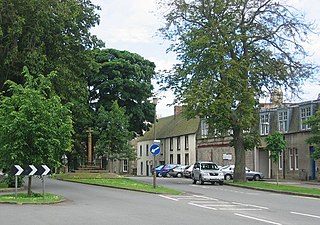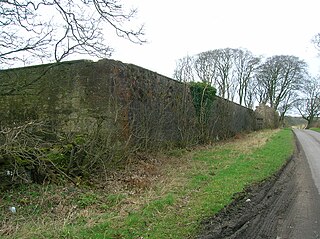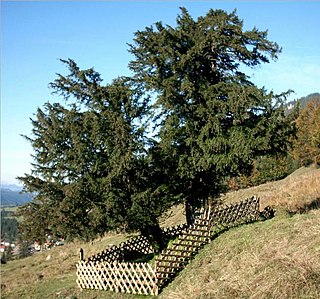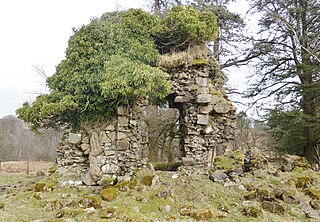
Houston, is a village in the council area of Renfrewshire and the larger historic county of the same name in the west central Lowlands of Scotland.
Craigends is a residential area in the civil parish of Houston and Killellan in Renfrewshire, Scotland lying south of the River Gryffe and on the banks of the River Locher. Craigends is on the south-eastern edge of the village of Houston, bordering the parish's other village, Crosslee. As with most of Houston, Craigends is predominantly a commuter settlement.

Taxus baccata is a species of evergreen tree in the family Taxaceae, native to Western Europe, Central Europe and Southern Europe, Northwest Africa, northern Iran, and Southwest Asia. It is the tree originally known as yew, though with other related trees becoming known, it may be referred to as the common yew, English yew, or European yew. It is primarily grown as an ornamental. Most parts of the plant are poisonous, with toxins that can be absorbed through inhalation and through the skin; consumption of even a small amount of the foliage can result in death.

Ormiston is a village in East Lothian, Scotland, near Tranent, Humbie, Pencaitland and Cranston, located on the north bank of the River Tyne at an elevation of about 276 feet (84 m).

The Fortingall Yew is an ancient European yew in the churchyard of the village of Fortingall in Perthshire, Scotland. Considered one of the oldest trees in Britain, modern estimates place its age at an average of 5,000 years.

Methuselah is a 4,855-year-old Great Basin bristlecone pine tree growing high in the White Mountains of Inyo County in eastern California. It is recognized as the non-clonal tree with the greatest confirmed age in the world. The tree's name refers to the biblical patriarch Methuselah, who is said to have reached 969 years of age before his death, thus becoming synonymous with longevity or old age in many European languages including English.
Thorntoun School was opened by Barnardo's in September 1971 for children with emotional difficulties aged 11 to 16 years. The school closed in 1990 and Thorntoun is now a nursing home. The complex lies between the villages of Springside and Crosshouse, Kilmarnock in East Ayrshire, Scotland. The old Thorntoun mansion house was demolished in the late 1960s, leaving the West Lodge, some of the home farm outbuildings, the stables and the walled garden as 'memorials' to the ancient history of the site. Many fine trees remain from the estate policies and the surviving gardens are very well maintained (2007). An entrance with a slight deviation from the old course has been created to serve the large modern buildings which house the nursing home.

Trysting trees are trees of any species which have, through their individual prominence, appearance, or position, been chosen as traditional or popular meeting places for meetings for specific purposes. Names, dates, and symbols are sometimes found carved on the bark, favouring trees with smoother bark, such as beech, hornbeam and sycamore.

Houston and Killellan is a civil parish in the county and council area of Renfrewshire in the west central Lowlands of Scotland. It contains the villages of Houston and Crosslee, as well as a number of smaller settlements including Barochan and Killellan in its rural hinterland.

The Llangernyw Yew ( ) is an ancient yew in the village of Llangernyw, Conwy, Wales. The tree is fragmented and its core part has been lost, leaving several enormous offshoots. The girth of the tree at the ground level is 10.75 m (35.3 ft).

Scotland is ideal for tree growth, thanks to its mild winters, plentiful rainfall, fertile soil and hill-sheltered topography. As of 2019 about 18.5% of the country was wooded. Although this figure is well below the European Union (EU) average of 43%, it represents a significant increase compared to the figure of 100 years previously: in 1919 it was estimated that only 5% of the country's total land area was covered in forest. The Scottish Government's Draft Climate Change Plan has set an aim of increasing coverage to 21% of Scotland by 2032, with the rate of afforestation rising to 15,000 hectares per year by 2024.

The Lands of Lainshaw lie in Strathannick and were part of the Lordship of Stewarton, in East Ayrshire, Scotland. Lainshaw House is a category B listed mansion, lying in a prominent position above the Annick Water and its holm in the Parish of Stewarton, Scotland. Part of the much older Lainshaw Castle is contained within the several later building phases of the present day Lainshaw House. The names 'Langshaw' or 'Langschaw' were used in historic times. Law Mount near the High and Laigh Castleton farms has been suggested as the site of the original castle, granted in the 12th century to Godfrey de Ross by Hugo de Morville.

The Lands of Ashgrove, previously known as Ashenyards, formed a small estate in the Parish of Kilwinning, North Ayrshire, lying between Kilwinning and Stevenston. The Georgian mansion house was demolished in 1960, the substantial walled garden survives.

Aspen is a common name for certain tree species; some, but not all, are classified by botanists in the section Populus, of the Populus genus.
Tree volume is one of many parameters that are measured to document the size of individual trees. Tree volume measurements serve a variety of purposes, some economic, some scientific, and some for sporting competitions. Measurements may include just the volume of the trunk, or the volume of the trunk and the branches depending on the detail needed and the sophistication of the measurement methodology.

The Balderschwang Yew is an ancient European yew in Bavaria. It has two hollow trunks and stands alone on a mountain pasture. It is estimated to be between 600 and 1,000 years old, and is possibly the oldest tree in Germany.

Cowden Hall, Cowdon Hall or Cowdenhall is an example of a laird's hall-house with a farmstead dating from more peaceful times in the seventeenth century when gun loops, thick defensive walls and well defended entrances were no longer essential and larger windows could be utilised. Eighteenth century additions included an outshot with a cruck roof. Cowden is located in an elevated position overlooking the Neilston Gap and the Levern Water on the lands of the old Barony of Cowden near Neilston in East Renfrewshire, Scotland.

The Ashbrittle Yew is an ancient yew tree located in the village of Ashbrittle, Somerset, in southwest England. The yew grows on a tumulus in the south-east end of the churchyard of St. John the Baptist. Yews are capable of living for several thousands of years; the Ashbrittle Yew itself is believed to be over 3,000 years old, but defining its precise age is difficult due to its hollow centre. The tree is formed of a hollow central trunk surrounded by six narrower boles. In 2015 its measured diameter was 39'11".

The Defynnog Yew (SN9253027960) is one of a group of ancient yews in the churchyard of St Cynog's Church, which serves the parish and the village of Defynnog, Powys, Wales. Defynnog is located close to Sennybridge, about ten miles west of Brecon, within the Brecon Beacons National Park.






















